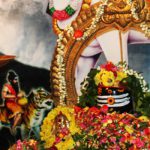Introduction
People celebrate Kartik Pooja across India. The month of Kartik is the most revered in the Hindu calendar as it is the only temple dedicated to Vishnu and Shiva. Devotees take a dip in the Ganges on this day. Kartik is the Hindu God of War. He is the God of male fertility and a good harvest. People wanting a son, offer prayers, performing a pooja on this day. The descendants of royal families have traditionally worshipped Kartik through the ages. Devotees celebrate Kartik Pooja for four consecutive days. People will celebrate Kartik Pooja on 16 November this year.
About Kartik, the God of War
Kartik is known by different names and worshipped in different states across India. He is called Skandan, Murugan, Velan Kumaran, etc. Kartik is the son of Parvati and Shiva; he is a part of the Trinity and the Hindu God of War.
Kartik is a significant deity revered across South Asia, and people mostly worship him in South India, Sri Lanka, Malaysia, Mauritius, and Singapore as Murugan. An ancient god, he has been traced back to the Vedic era. Found with Agni, the Hindu God of Fire, he is a God of medieval times. Mostly depicted in a youthful form, Kartik is the brother of Ganesha, the God of Beginnings.
Legend of Kartik
The deity of Kartik can be found mostly in regions inhabited by people of Tamil origin. According to legend, Kartik manifested for the sole purpose of killing the demon Tarakasura, who had become extremely powerful after being granted a boon by the Creator, Brahma himself. Confident that no one could defeat him, Tarakasura believed that only someone as powerful as Shiva could kill him. After the marriage of Shiva to Parvati, they meditated in a cave, and a ball of fire emerged from their cosmic energies. Not even Agni, the God of Fire could hold the heat, and Ganga, unable to carry it herself, left it in a lake among reeds. Goddess Parvati took the form of the water-energy, as she alone could bear the heat of Shiva and Shakti.
Finally, Kartik emerged as a baby with six faces – Eesanam, Sathpurusham, Vamadevam, Agoram, Sathyojatham, and Adhomugam. Hence, he bore the name Shanmugam or Shadanan. According to legend, Kartik was taken care of by six mothers symbolizing the six stars of Kritika cluster. He grew up to be a philosopher-warrior.
Kartik is usually shown astride a peacock called Paravani. The peacock was originally an asura by the name of Surapadma, and the rooster, Krichi, an angel. Surapadma challenged Kartik to combat and later repented. He assumed the form of a tree, which Kartik halved into two with his mace. From one half, he pulled out a rooster, which became his emblem. The other half became a peacock, which was his mount.
Kartik carries a spear called the Vel. It is a symbol of Kundalini Shakti (divine energy). He is also known as the Deva Senapati, or the general of the Army of Gods. Known for his extraordinary skills, he is perfection personified. Kartik is highly intelligent and extremely skilled in warfare. He has fought and destroyed numerous demons that reflected negative human energy.
Rituals Associated with Kartik Month
Devotees offer a ghee lamp to Krishna every day during this month. They remember and chant the name of Hari, the Supreme God. Listening to the Srimad Bhagavatam (Vedic literature) is beneficial. Devotees can only consume Prasadam (food offering to God). A lamp should be offered to Tulsi Dev every day. Devotees practice celibacy and austerity.
Significance of Kartik Month
The Kartik month occurs in the eighth lunar month of the Hindu calendar. It is considered the holiest month among all lunar months. Dedicated to the worship of both Vishnu and Shiva, the month of Kartik holds immense importance. Kartik is the best, the purest, and most glorious of all months. Even a small vrat (fast) can give good results. The effect of a Kartik Vrat lasts for one hundred lifetimes. It is a month held very dear to Krishna.
The lighting of the lamp signifies the visual experience as it allows us to see and have perception. The light also reflects awareness and ultimate liberation. It also means multiplying light in our life. Women observe the festival of Karwa Chauth (a fast ritual for longevity and well-being of husbands) during this month. On the new moon of Kartik Month, one of the most important festivals of lights, Deepawali or Diwali, is celebrated. Worshipping the Tulsi (basil) assumes a special significance during the month of Kartik. People consider it very favorable to take a dip in the holy Ganges river this month. The rituals of this dip start on Sharad Poornima and end on Kartik Poornima. The process is called Kartik Snan (dip/bath).
Observances and Rituals of Kartik Pooja
Devotees observe a fast on Kartik Pooja, from dawn to dusk. The fast is completed only after the pooja is offered to Shiva or Vishnu. People performing the fast do not consume even a drop of water. People observing a mild version of the fast can have milk, water, and fruits.
Devotees clean the place of worship. They place an idol of Shiva or Vishnu on the altar and decorate the pooja area with flowers, vermillion, turmeric paste, and incense sticks. They light a lamp and sprinkle water over the entire pooja area, chanting all the while. They offer flowers and chant the names of Shiva and Vishnu. The Kartik Pooja is concluded by doing Aarti (lamp ceremony) and praying for happiness and prosperity. Devotees donate clothes, food, and money to the needy.
Temples Celebrating Kartik Pooja
People worship Kartik across South India in numerous temples built across Palani, Kumbakonam, Thiruchendur, Tirupparankunram, Thiruttani, and Madurai. There are temples in Malaysia, Sri Lanka, and Australia too.
